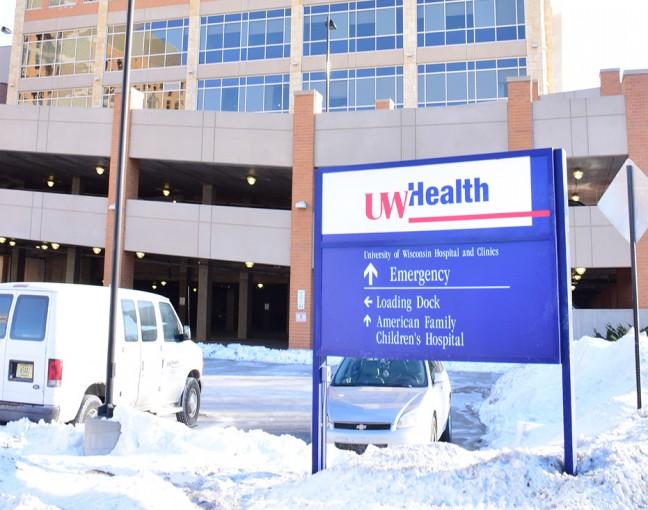As the COVID-19 pandemic continues to spread internationally at an exponential rate, University of Wisconsin professionals are working to fulfill the increasingly high demand for personal protective equipment.
PPE can include face masks and shields, gloves, goggles and other protective clothing which can be used in combination with other infection control measures, such as hand sanitizer and hand-washing, according to the Food and Drug Administration.
Widespread demand for PPE throughout the country inspired various UW personnel to create these items with on-campus facilities to assist hospitals or medical suppliers who may need them. In the School of Pharmacy, the Zeeh Pharmaceutical Experiment Station team produces hand sanitizer for UW Health hospital as well as on-campus isolation facilities, including dorms.
Director of the Zeeh Pharmaceutical Experiment Station Edmund Elder spoke about the decision to produce hand sanitizer.
“[UW Health] realized they may not be as good on their supplies as they thought they would be as there started to be a rush on things throughout the market,” Edler said. “So, we looked at how we could start ramping up production.”
UW Health prepares for uncertainty of peak patient numbers amid COVID-19 pandemic
The hand sanitizer, which is created with only four ingredients— alcohol, hydrogen peroxide, glycerol and water — is a formulation based on the World Health Organization’s recommendation, according to Elder.
The ingredients are mixed together and locked in a fume hood to prevent a fire hazard as well as to protect those mixing the substance from being overcome with alcohol fumes, Elder said.
“It’s not like the commercial hand sanitizer where it’s a gel, it’s actually a liquid and it’s got a higher alcohol content in it to kill viruses,” Elder said. “So Purell or other brands of commercially available hand sanitizer have 70% alcohol content and those are tested to make sure that they kill bacteria. We’re dealing with a virus — viruses are more difficult to kill, usually, than bacteria.”
Evers signs executive order to supplement federal support for health care workers
After the hand sanitizer is made, it is packaged in totes and transported to the central supply for UW Health. On campus, the bottles of hand sanitizer are picked up daily for separate use, according to Elder.
In other cases, however, the PPE made on campus was not initially as easy to distribute. When the UW Division of Information Technology’s Digital Publishing and Printing Services assisted in the creation of the Badger Shield, a protective face shield for hospital workers, it soon became difficult for manufacturers to match the products with those who needed them.
UW Assistant Professor of Industrial and Systems Engineering Justin Boutilier spoke about this distribution issue.
“So when [Badger Shield] started, manufacturers started picking it up and requesting it, so as the scale — the number of hospitals and the number of manufacturers getting involved—started increasing, manually matching them started to become infeasible because of the size,” Boutilier said.
Thus, Boutilier, along with biomedical engineering graduate student Rebecca Alcock, began to work in collaboration with University of California, Los Angeles professor Auyon Siddiq to create a website entitled “shield-net” to match manufacturers of face shields to hospitals.
On the website, two options appear — “I need face shields,” and “I make face shields.” From there, Boutilier said the website collects information about manufactures willing to produce the shields and hospitals that need them. The website uses an optimization algorithm which finds the best matches according to urgency, location, order size, manufacturer size and production size, according to Boutlier.
UW Health receives face shields, hand sanitizer from UW faculty, local companies amid pandemic
“We try to make it somewhat equitable so that not a single hospital or a single manufacturer gets all of the matches,” Boutilier said. “On the manufacturer side, many of the manufacturers who were producing face shields are able to stay open because of this.”
Boutilier said another reason why the website is successful is because it connected hospitals to manufacturers who may not be aware certain manufacturers switched to producing face shields. Additionally, shield-net is successful in connecting smaller hospitals with local manufacturers, according to Boutilier.
There are requests for over five million shields all across North America — and some outside of North America — from smaller manufacturers to large companies like Ford and Koehler, Boutilier said.
Both Elder and Boutilier expressed a similar sentiment about the experience of having the ability to assist in the distribution of PPE.
“We’re having a lot of fun doing it, it’s a lot of work but it’s highly needed on campus, the hospital and the other isolation centers,” Elder said. “We’ve got the capabilities to do it, so we’re happy to be doing it.”














